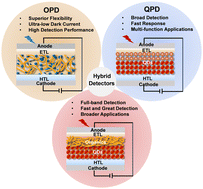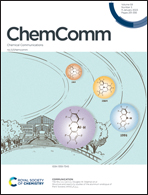Organic and quantum dot hybrid photodetectors: towards full-band and fast detection
Abstract
Photodetectors hold great application potential in many fields such as image sensing, night vision, infrared communication and health monitoring. To date, commercial photodetectors mainly rely on inorganic semiconductors, e.g., monocrystalline silicon, germanium, and indium selenide/gallium with complex and costly fabrication, which are hardly compatible with wearable electronics. In contrast, organic conjugated materials provide great superiority in flexibility and stretchability. In this Highlight, the unique properties of organic and quantum dot photodetectors were firstly discussed to reveal the great complementarity of the two technologies. Subsequently, the recent advance of organic/quantum dot hybrid photodetectors was outlined to highlight their great potential in developing broadband and high-performance photodetectors. Moreover, the multiple functions (e.g., dual-band detection and upconversion detection) of hybrid photodetectors were highlighted for their promising application in image sensing and infrared detection. Lastly, we present a forword-looking discussion on the challenges and our insights for the further advancement of hybrid photodetectors. This work may spark enormous research attention in organic/quantum dot electronics and advance the commercial applications.

- This article is part of the themed collection: 2022 Emerging Investigators


 Please wait while we load your content...
Please wait while we load your content...